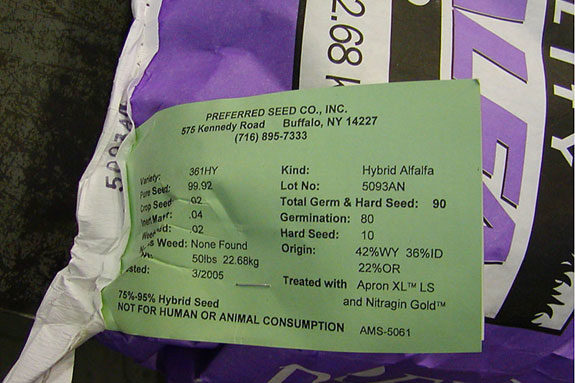Forage blends, including single-species blends from most seed suppliers, contain seed of relatively high quality. However, depending on the supplier, blends may range from high germination and high purity to products with low purity and significantly lower germination (often this is older seed).
Seed tags will indicate the crop species, total germination level, pure seed content, crop purity and weed seed content. Be cautious of blends with a tag showing relatively low crop purity. For example, if the tag says there is 3 percent “other crop,” don’t be surprised if the new alfalfa seeding looks like a stand mixed with canola.
A helpful calculation is to determine the amount of pure live seed in a bag. To make this calculation, multiply the percentage of total germ (listed on the bag tag) times the percent of pure seed, then multiply that number by the total bag weight. This shows the total amount of pure live seed in the bag. The figure you get can be helpful when adjusting seeding rates between widely varying blends.
Seeding rates may need to be increased if the pure seed is low. Some seed is marketed with up to 34 percent or more coating material. This may not be apparent on the tag, except for the fact that the percentage of pure seed will be reduced. If the tag shows 66 percent pure seed that means 34 percent is coated.
Once you determine the germ quality and seed purity of a blend, the next question should be about component varieties and their attributes. The value proposition of a blend can fall apart if a grower wants a certain minimum standard of traits or performance. It’s helpful to know how the seed trade sources materials for blends.
Alfalfa product options
There are two main sources for blended forage seed in the marketplace. At one end of the seed trade, there is “common seed” produced by individual farmer-seed growers. In some crops, such as alfalfa, clovers and forage grasses, growers can purchase “brown-bag” VNS (variety not stated) products produced by individual farmers who allow a field to go to seed. This is not legal if the product involves PVP-protected (Plant Variety Protected) or patented varieties or with varieties containing proprietary transgenic traits.
For these reasons, this source of VNS seed has dwindled to near zero in transgenic crops such as corn and soybeans. In forage grasses and legumes, this “farmer-source” seed generally finds its way into the market through seed brokers. Rather than the traditional brown-bag VNS, these products often are sold in fancy bags as micro-brands marketed through retailers and companies possessing no seed production, conditioning or bagging capability.
At the other end of the seed trade spectrum, some major seed brands offer blends, typically from their own genetics and produced through normal production channels. These blends are sold without stating the variety, allowing seed companies the option of selling excess inventory.
These blends usually include a mix of current or past commercial seed varieties. They may include inventory that does not meet the company’s internal specifications for varietal purity. For all these reasons, the varietal components in blends can vary from lot to lot and from year to year.
Some blends offer more valuable descriptive information. Reputable seed suppliers take extra measures to ensure blends meet minimum winterhardiness, dormancy and disease resistance criteria for the specific region in which the blend will be sold.
Some seed companies have built name recognition around premium blend products, with a consistent brand name and stated trait minimums, such as a guaranteed minimum disease resistance or dormancy. These premium blends may restrict the company’s options for varietal components and may cost more, but they offer growers information about expected performance.
When a premium blend approaches the price of a pure variety, growers should be leery. Unless all the varietal components of a blend are known and there’s a specific reason for their inclusion levels, it’s likely better to purchase a pure variety that fits each field’s specific needs.
Decide what you need
Single-species blended forage products may provide suitable performance for short rotations or for field situations where specific pest resistance traits or performance of a pure variety aren’t needed or valued.
Consider blends from a trusted company. Carefully study the economic impact of increased variability and reduced performance of blends in fields seeded down only every three to five years.
Pay special attention to seed tag information, setting expectations for crop purity, in addition to the amount of pure seed and total germination that ultimately impacts the needed seeding rate. Consider information on alfalfa adaptation and performance. Don’t overpay for a blend that doesn’t offer traits needed for individual fields and specific growing environments. FG
PHOTO
TOP: Photo courtesy of Cornell University.

Robin Newell
Senior Forage Business Manager
Pioneer Hi-Bred











